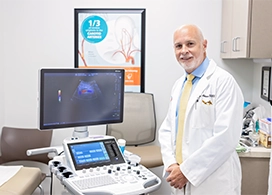
Would you recognize Peripheral Artery Disease if you had it?
Peripheral artery disease, or PAD, can cause painful leg cramping, along with numbness and weakness. And while these symptoms are uncomfortable, they can also be an important leading indicator for more serious ailments including coronary heart disease or a heart attack.
PAD causes a narrowing of the arteries that carry blood away from your heart to other parts of your body, including your legs, stomach, arms, and head. The limited blood flow caused by that narrowing is often the culprit of cramps in your hips, thighs, or calf muscles. PAD can also make it difficult or painful to walk or climb stairs. Typically, the pain will go away once you rest and will return when you walk or climb steps again.
Why does a PAD diagnosis matter?
Many people who have peripheral artery disease mistake their symptoms for something else. In fact, PAD often goes undiagnosed by healthcare professionals as well. Because people with peripheral arterial disease have a higher risk of coronary artery disease, heart attack, or stroke, it’s important for you to share any of these symptoms with your physician.
In addition to an increased risk of heart attack or stroke, PAD can also lead to gangrene or amputation if left untreated.
What’s your risk of PAD?
A number of factors can impact your risk of PAD, including your age. Other factors can increase your chances for peripheral artery disease, including high blood pressure or high cholesterol. Smoking also puts you at an especially high risk for developing PAD, as does diabetes.
How is PAD diagnosed?
If you have any of the symptoms of PAD, talk to your doctor about conducting simple tests to determine if further evaluation is needed, all of them painless and non-invasive.
During your regular physical exam, your doctor can check for a weak or absent pulse or listen for a tell-tale whooshing sound through a stethoscope. Poor wound healing in the affected area and decreased blood pressure can also be strong indicators that additional tests may be warranted. Your doctor can also compare the blood pressure in your ankle with the blood pressure in your arm to determine your ankle-brachial index (ABI), or ask you to walk on a treadmill to check blood pressure before and during exercise.
Additional testing, such as Doppler ultrasound, can also help your doctor further evaluate blood flow through your blood vessels and identify blocked or narrowed arteries. An angiography – in which a dye is injected into your blood vessels – offers another way to view blood flow through your arteries as it happens. Your doctor can trace the dye flow using X-ray imaging, magnetic resonance angiography (MRA), or computerized tomography angiography (CTA).
What can you do about it?
If you’ve noticed some of the symptoms of peripheral artery disease or if you’re in a high-risk group, it’s worth noting that you can take control of your risks. And if you are diagnosed with PAD, you can also manage the disease itself – and reduce your risks for more serious possible outcomes – by following your doctor’s recommendations and adopting a heart-healthy lifestyle.
While there’s no cure, you can significantly reduce your symptoms with medication and lifestyle changes including changes in diet, increased exercise, and stopping smoking. It can also be important for you to find and regularly visit a vascular specialist to make sure you are successfully managing your PAD.
Why choose Vascular Center of Mobile?
For more than 30 years, the Vascular Center of Mobile has provided full-service vascular surgery and endovascular care. We specialize in diagnosing and treating artery and vein disorders with minimally invasive techniques and care options, including ultrasound, duplex, and Doppler flow studies for arteries and veins.
We take pride in offering state-of-the-art procedures to meet all vascular treatment needs. We also work hard to put our patients first, treating them as we would our own family. We are proud to offer our knowledge of vascular disease to you and your loved ones.
If you are in a high-risk group for arteriosclerosis – age 55 or older, a smoker, or have diabetes –please consider visiting the Vascular Center of Mobile for an assessment. Early detection and treatment can make a significant difference in your health and could ultimately save your life.